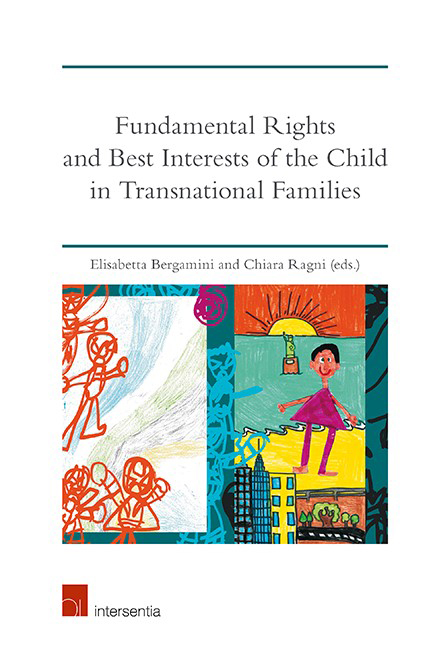Book contents
- Frontmatter
- Dedication
- Preface
- Acknowledgements
- Contents
- List of Cases
- List of Authors
- PART I THE IMPACT OF HUMAN RIGHTS AND OF THE BEST INTERESTS OF THE CHILD ON EU FREE MOVEMENT AND MIGRATION LAW
- PART II THE BEST INTERESTS OF THE CHILD AS A CONCERN OF HUMAN RIGHTS AND EUROPEAN PRIVATE INTERNATIONAL LAW
- The Place of Human Rights in the Private International Law of the Union in Family Matters
- The Best Interests of the Child Principle at the Intersection of Private International Law and Human Rights
- Recognition of a Foreign Status Filii: Pursuing the Best Interests Principle
- Surrogacy Arrangements and the Best Interests of the Child: The Case Law of the European Court of Human Rights
- Cross-Border Recognition of Adoption: Rethinking Private International Law from a Human Rights Perspective
- Protecting Children's Rights aft er Child Abduction: The Interaction of the CJEU and ECtHR in Interpreting Brussels II bis
- Cross-Border Parental Child Abduction in the EU: Is there Room for a Human Rights Exception?
- Impact of the Best Interests of the Child on the Brussels II ter Regulation
- Provisional Measures and the Best Interests of the Child in the Field of Parental Responsibility
- Index
- About the Editors
Protecting Children's Rights aft er Child Abduction: The Interaction of the CJEU and ECtHR in Interpreting Brussels II bis
from PART II - THE BEST INTERESTS OF THE CHILD AS A CONCERN OF HUMAN RIGHTS AND EUROPEAN PRIVATE INTERNATIONAL LAW
Published online by Cambridge University Press: 12 November 2019
- Frontmatter
- Dedication
- Preface
- Acknowledgements
- Contents
- List of Cases
- List of Authors
- PART I THE IMPACT OF HUMAN RIGHTS AND OF THE BEST INTERESTS OF THE CHILD ON EU FREE MOVEMENT AND MIGRATION LAW
- PART II THE BEST INTERESTS OF THE CHILD AS A CONCERN OF HUMAN RIGHTS AND EUROPEAN PRIVATE INTERNATIONAL LAW
- The Place of Human Rights in the Private International Law of the Union in Family Matters
- The Best Interests of the Child Principle at the Intersection of Private International Law and Human Rights
- Recognition of a Foreign Status Filii: Pursuing the Best Interests Principle
- Surrogacy Arrangements and the Best Interests of the Child: The Case Law of the European Court of Human Rights
- Cross-Border Recognition of Adoption: Rethinking Private International Law from a Human Rights Perspective
- Protecting Children's Rights aft er Child Abduction: The Interaction of the CJEU and ECtHR in Interpreting Brussels II bis
- Cross-Border Parental Child Abduction in the EU: Is there Room for a Human Rights Exception?
- Impact of the Best Interests of the Child on the Brussels II ter Regulation
- Provisional Measures and the Best Interests of the Child in the Field of Parental Responsibility
- Index
- About the Editors
Summary
INTRODUCTION
International parental child abduction represents a fundamental breakdown of family relationships. It has the potential to severely affect or destroy the relationship between the child and one parent, and to affect the child's welfare into adulthood. As the subject of child abduction proceedings, the child's rights should be protected, particularly their right to have decisions taken in their best interests, and their right to be heard in decisions affecting their interests.
In the European Union (EU), the Hague Convention on the Civil Aspects of International Child Abduction 1980 (Hague Abduction Convention) and the Brussels IIa Regulation both seek to remedy an abduction by returning the child to their habitual residence prior to the abduction. Despite the importance of protecting the rights of abducted children, the law on child abduction does not make direct reference to the best interests of the child. The interpretation and application of the return remedy and the protection of children's rights in this context has been subject to litigation in the two supranational European courts: the European Court of Human Rights (ECtHR), and the Court of Justice of the European Union (CJEU). This chapter will explore the problems and challenges that have developed in the jurisprudence of these two supranational courts in attempting to protect children's rights on child abduction. In particular, the patchwork of children's rights instruments and the relationship between the ECtHR and the CJEU have resulted in inconsistencies in approach. It will be suggested that the supranational context is a difficult environment to further develop children's rights, given the spatial and temporal distance of the courts from the dispute. Whilst these courts are important to the promotion of children's rights, it will be suggested that the domestic courts remain the key forum for the protection of children's rights on child abduction.
The first section will examine the children's rights framework and the range of children's rights instruments applied within Europe. The legal framework remedying international child abduction within the EU will also be outlined. The key case law of the ECtHR and the CJEU will be analysed in the third section for their interpretation and application of children's rights on child abduction.
- Type
- Chapter
- Information
- Publisher: IntersentiaPrint publication year: 2019

